The International Fruit Tree Association’s 64th annual conference in February was held virtually, but that didn’t stop IFTA from visiting leading Honeycrisp orchards across North America. Video “bus tours” took attendees to four orchards, where expert Honeycrisp growers described how they grow the profitable, but difficult, variety in their regions.
This story will cover two of the stops: in Washington and Nova Scotia, Canada. The Michigan and New York stops will be featured in the April 15 issue of Good Fruit Grower.
Washington state
At Chiawana Orchards in Yakima, Washington, grower Bruce Allen talked Honeycrisp with Washington State University extension specialist Bernardita Sallato and Jeff Cleveringa, head of research and development at Oneonta Starr Ranch Growers. The three stood in a standard Honeycrisp block planted 2-by-12 feet in 2015. The trees are on Pajam 2 and Nic.29 rootstocks and trained to a V-trellis system.
Allen said the upper Yakima Valley gets about 7–9 inches of precipitation annually, and it’s not uncommon to experience prolonged stretches of 100-degree temperatures during the growing season. He said the yield goal for the block is 80 bins per acre at maturity. It’s possible to exceed 90, maybe even 100, bins per acre, but fruit quality gets “dodgy” at that point. This particular block generally has pretty good canopy uniformity, so 80 bins is a sustainable target. He aims for size counts of 64 to 80.
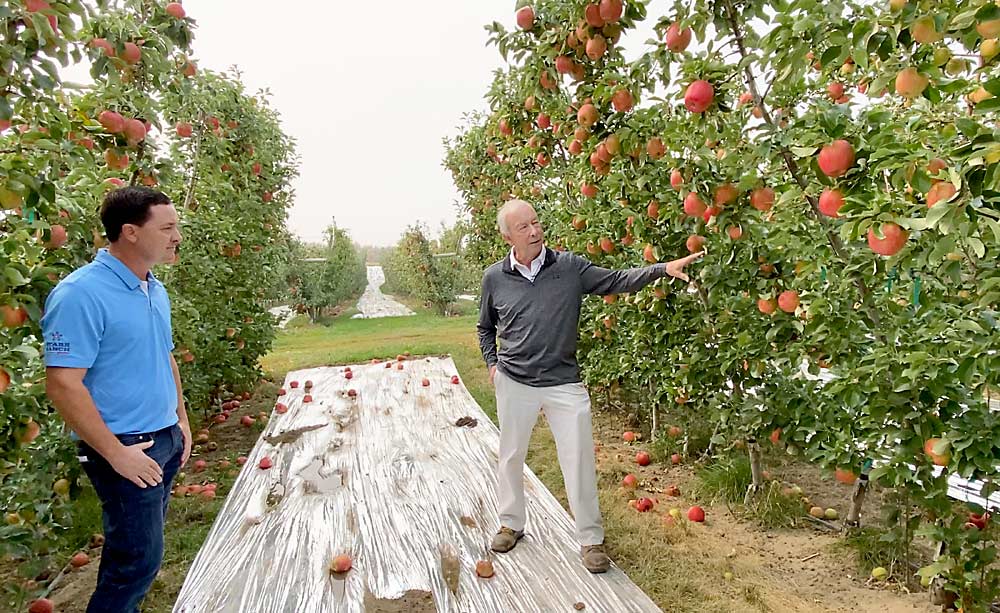
The land they were standing on has held apples for more than a century, Allen said. Before replanting, Chiawana followed its standard program of deep ripping and preplant fumigation. The orchard team usually puts down more than 30 tons of compost in the first year, followed by 10 tons in the second year. They would like to have enough canopy growth to get fruit on the tree by the third leaf, when they start to slow down fertility to calm the tree. By the fourth year, they want a tree that’s reached the top wire and has started filling in the canopy. That’s when they start a targeted Apogee (prohexadione calcium) program in the bottom two or three wires, to fight bitter pit.
“The first rule of being an apple farmer is to grow your canopy as fast as possible,” Allen said. “If you don’t have a canopy, you can’t grow fruit.”
Allen said the formal system of a single leader with scaffolds tied horizontally along wires is no longer planted by Chiawana Orchards, because it requires too much labor. He prefers V systems with multiple vertical leaders, which have become the company’s new standard, because the only training required is for maintaining the vertical orientation and proper spatial separation (18 inches) between the leaders.
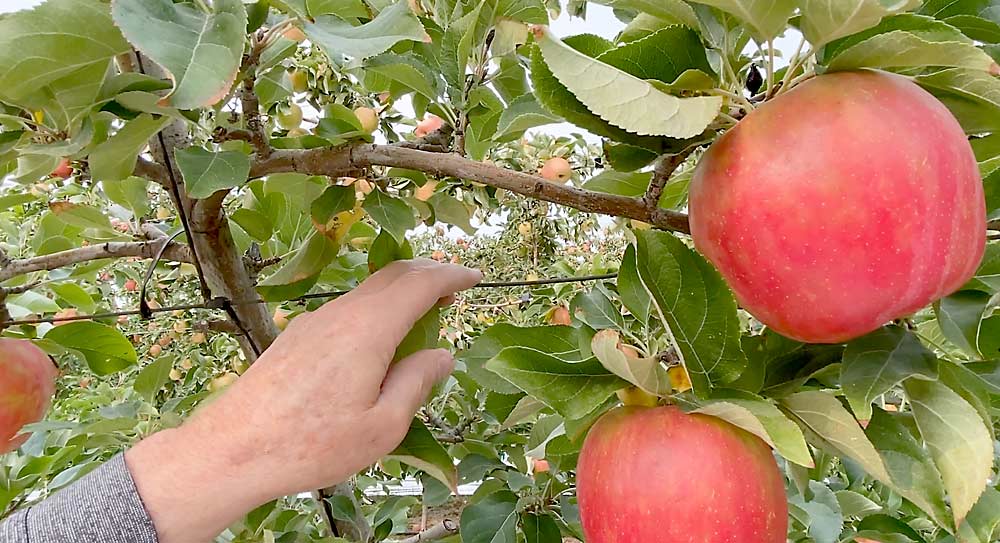
Allen discussed many aspects of his approach to precision crop load management:
—It’s more important to get chemical thinning right than to save money. In Washington, an adequate program is likely to be four or more sprays. It is important to get your spray rate correctly adjusted to the crop load you are targeting. Trying to chemical thin with only two or three sprays likely will give less than optimal results.
—Hand thinning too early leads to fruit that’s too big. His general recommendation is to thin other varieties before hand thinning Honeycrisp. If deficit irrigation is used, delaying thinning will significantly increase its impact on fruit size.
—Alternate bearing needs to be addressed with detailed pruning. If properly done, subsequent years will not require the same level of pruning to adjust fruit sites to a reasonable number. Detailed pruning will get your trees into a good balance of fruiting and resting spurs, if done correctly. It is much more difficult to achieve this with chemical thinning.
—Separating the canopy into zones, and counting fruit within each zone rather than counting by tree, is more precise. Let’s say you have a 2-by-13 planting (1,635 trees per acre) and you want to grow 80-size fruit (assuming a 10–15 percent cullage rate). It’s “simple math” to calculate that you need 100 apples per tree. If you have six wires, that’s six canopy zones. Dividing the target number of apples per tree (100) by 6 gets you about 16 apples per zone. So, when counting the fruitlets, if you have fewer than 16 you know you’re overthinning; if you have more than 16, you know you’re underthinning.
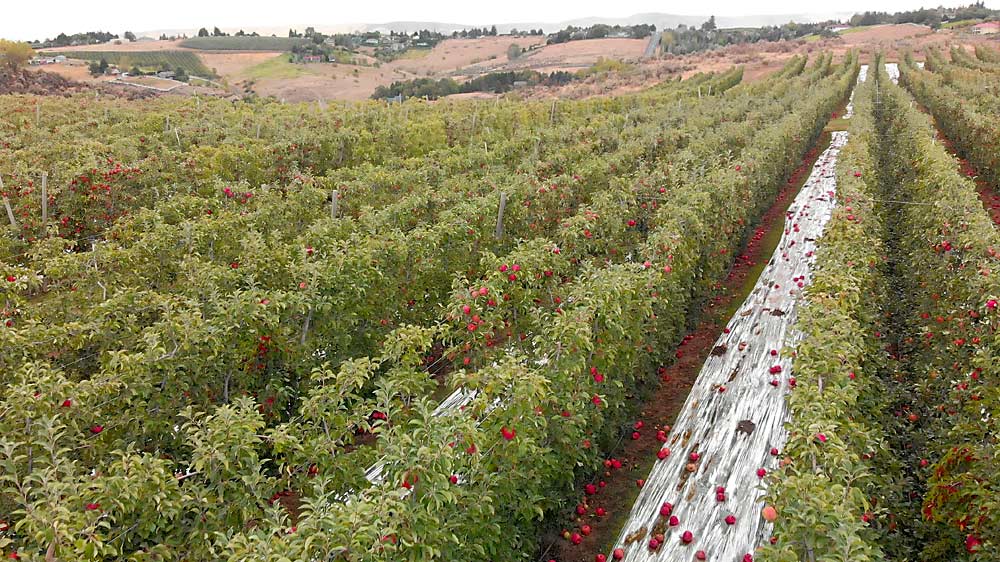
Nova Scotia
At the other end of North America, grower Waldo Walsh and Perennia tree fruit specialist Michelle Cortens talked about growing Honeycrisp in Nova Scotia.
Walsh, owner of Birchleigh Farms in Berwick, has been growing Honeycrisp since 1996, but he admits he still does not have it all figured out. He currently grows 35 acres of the variety.
Nova Scotia’s maritime climate can drop up to 57 inches of precipitation annually. The growing season is short and has a lot of unpredictable weather. In 2018, for example, Walsh lost a third of his crop to a once-in-a-century freeze on June 4. He dodged hail damage in 2019, but Hurricane Dorian knocked some trellises over that September.
Walsh also shared the advantages of growing Honeycrisp in Nova Scotia: The generally cool climate promotes good fruit coloring. The apples end up a little smaller than they do in other growing areas, but that’s a good thing — they’re nice and hard and good for long-term storage. Internal browning and storage scald are usually not an issue.
On Sept. 25, the verge of Honeycrisp harvest, Walsh and Cortens stood in a Honeycrisp block planted in 2008. It’s a spindle bush planting spaced 4- by 14-feet on M.26 rootstocks. The site, which has been growing apples for more than a century, was fumigated before replanting.
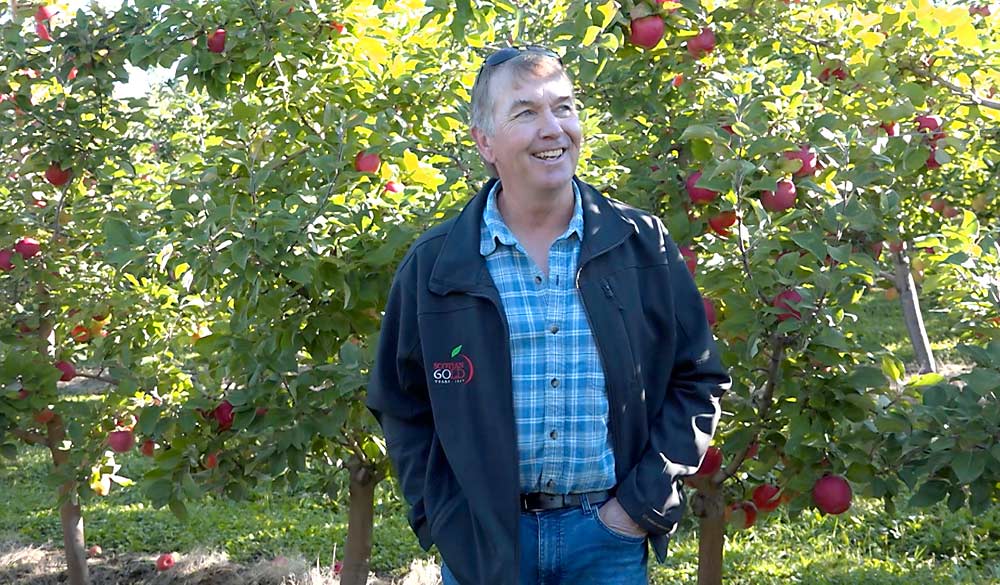
Walsh’s goal with such blocks is to be in production by fourth leaf and to get an average annual yield of 50 bins per acre at maturity. He ended up harvesting 42 bins per acre of Extra Fancy Honeycrisp in 2020, with a minimum of 50 percent red coloring. Most of the apples had a size count between 88 and 64. The “sweet spot” for Honeycrisp right now is between 88 and 80 — bagged apples are in big demand during the pandemic, he said.
Walsh still grows some Honeycrisp on semidwarf plantings, too. Provincial growers are gradually transitioning from semidwarf to dwarf, but some trees on dwarfing rootstocks have struggled to fill their space in Nova Scotia, and many growers are now reevaluating their rootstock choices. He planted some M.7s in 2020.
Walsh used to rely on a horizontal, four-wire training system, but he thinks Honeycrisp, with its weak growing nature, needs vertical support. He is currently planting a four-wire system with a 10-foot piece of bamboo for vertical support.
Biennial bearing is always a concern when dormant pruning Honeycrisp, Walsh said, so he has to adapt. If the previous year’s crop was light, Walsh will prune heavier. If the crop was heavy, he’ll prune lighter. His workers use a motorized platform and pneumatic pruning shears to do most of the work.
When dormant pruning, he makes sure to leave himself twice as many buds as his target crop load. Poor weather at pollination can lead to poor fruit set, so he needs to leave himself plenty of extras. At a 4-by-14 spacing, his target crop load is 100 to 110 apples per tree.
At full bloom, he uses ATS (ammonium thiosulfate) to blossom thin Honeycrisp. He follows up with Fruitone L (1-naphthaleneacetic acid) and Sevin (carbaryl) to fruitlet thin. Chemical thinning results can vary due to unpredictable weather. This past year was especially challenging because of unprecedented high temperatures after his fruitlet thinners were applied. Initially, he was concerned that he had overthinned, but he ended up harvesting a reasonable crop with very little adjustment from hand thinning, which he does every year. He also is experimenting with mineral oils to enhance his thinning program.
Walsh shared other observations with IFTA:
—His two biggest inputs are pesticides and labor.
—Like most Nova Scotia growers, he doesn’t irrigate but is wondering if he should. The natural rainfall in the last few years has been unpredictable. The 2020 growing season was very hot and dry, and the trees could have used more water.
—In general, scab is not a big problem in Nova Scotia Honeycrisp, unlike summer diseases such as black rot. Bitter pit generally isn’t an issue, either, but with a warming climate he’s becoming a little more concerned.
—Wildlife damage, especially from deer, can be a problem on young plantings. He’s trying to mitigate that by putting up fences.
—He uses hen or beef manure, along with fumigation, to enhance tree growth when planting new orchard blocks. •
—by Matt Milkovich

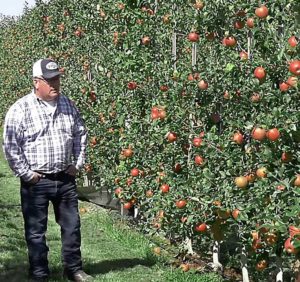





Leave A Comment